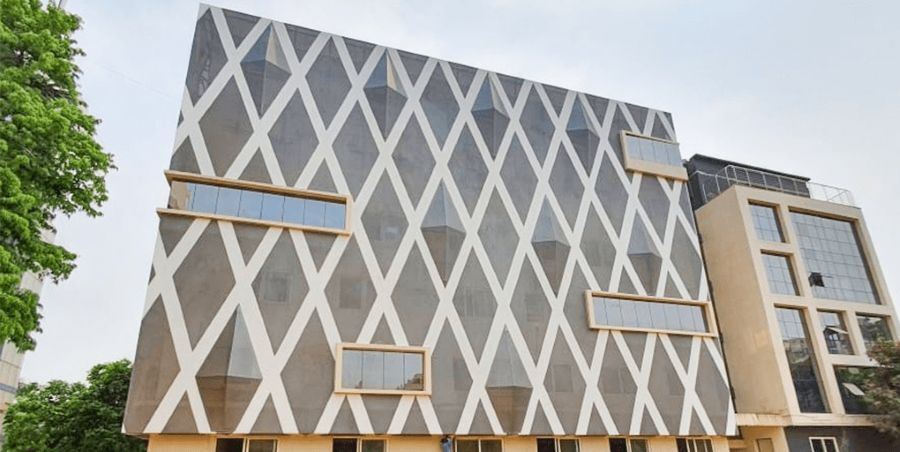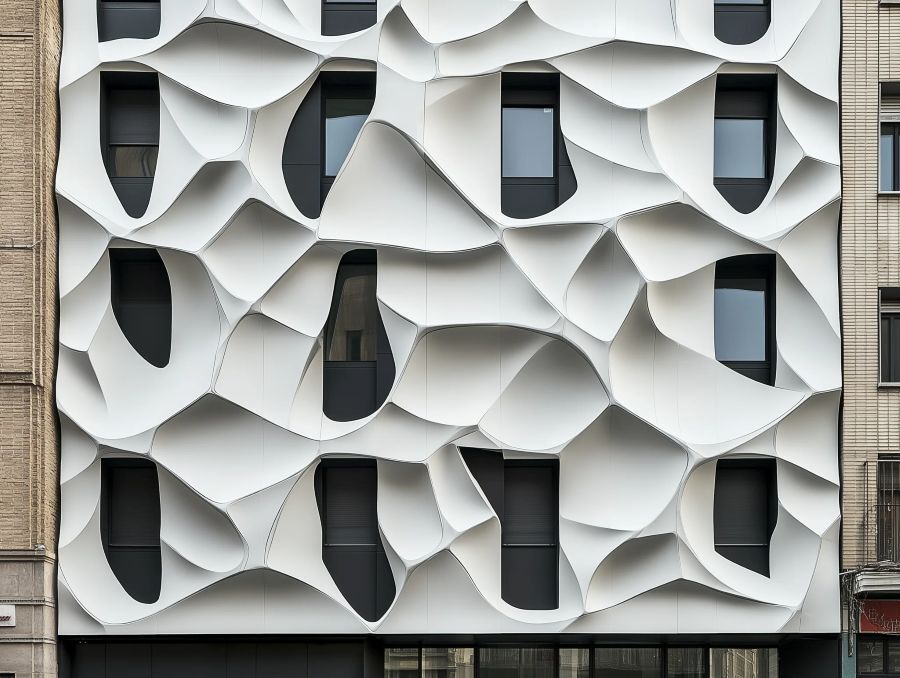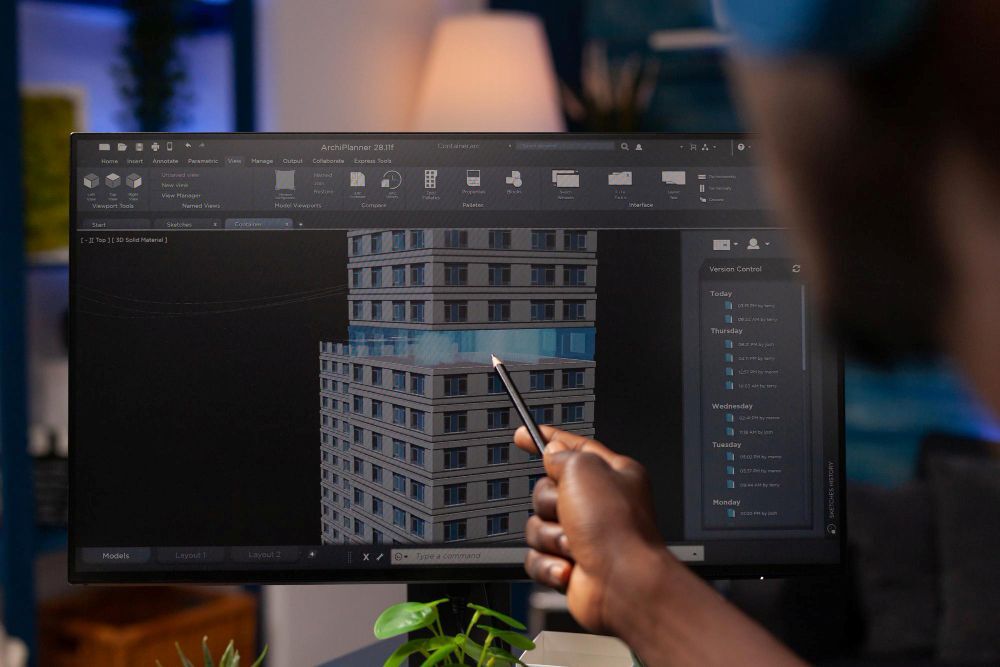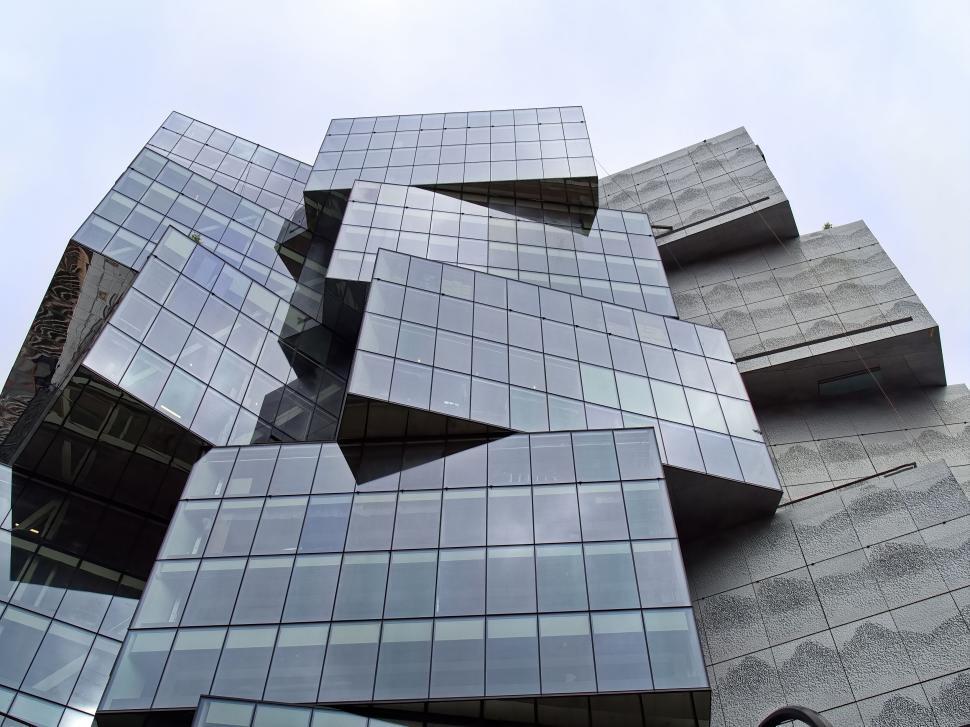Master High-Performance Facade Design: A Comprehensive Guide in 2025
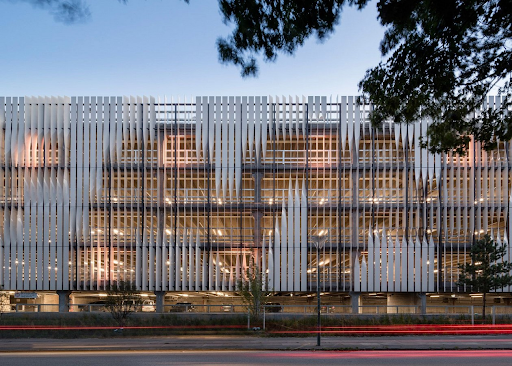
Table of Contents
Facade design architecture of a building is often the most visually striking aspect of its exterior. It constitutes an interesting play of volume, scale, light, and shadow that creates an impressive visual while enhancing the functioning of the building. Although building modern facade design architecture has always been a topic of interest for designers, the advent of modern tools and processes has further fueled them to innovate futuristic facades.
What is the Difference Between a Building Elevation and a Building Facade?
A building elevation refers to a flat representation of one side of a building, typically drawn to scale and showing key architectural features such as windows, doors, and structural elements. Architects use elevation drawings to convey the external appearance and dimensions of a building from a specific viewpoint. On the other hand, facade design architecture encompasses the entire external surface of a building, including all sides and architectural elements visible from the exterior. The facade represents the overall design concept and the aesthetic expression of the building, incorporating materials, textures, colours, and detailing to create a cohesive and visually appealing exterior.
What are the Various Types of Building Facades?
The facade of a building serves as its outer shell but also plays a crucial role in defining its aesthetic appeal, functionality, and sustainability. So,
1. Traditional Facades
Traditional building facades often showcase architectural styles and materials that reflect the cultural and historical context of a region. Common features include brickwork, stone cladding, ornate detailing, and symmetrical designs.
2. Modernist Facades
Materials such as glass, steel, and concrete dominate modernist architecture, creating sleek and geometrically inspired facades. Large windows and open spaces are common features, emphasizing functionality and the integration of natural light into interior spaces.
3. Contemporary Facades
These facades often combine traditional and modern elements, resulting in dynamic and visually striking designs. Contemporary facades may incorporate sustainable materials like recycled glass, timber cladding, and innovative composite panels. They also prioritise energy efficiency through smart shading systems, passive design strategies, and green technologies.
4. High-Performance Facades
High-performance building facades are designed to optimise energy efficiency, indoor comfort, and environmental sustainability. These facades incorporate advanced materials, technologies, and design strategies to reduce energy consumption and enhance building performance.
What are High-Performance Building Facades?
High-performance building facades are building envelopes that act as the external shell of a building separating the indoor environment from the outdoor elements. A high-performance building facade typically includes features such as insulation, shading devices, efficient glazing, ventilation systems, and air barriers. These components work together to control heat transfer, air leakage, and moisture infiltration, which can have a significant impact on the energy use and overall performance of a building. Additionally, they help enhance the visual appeal of a building while providing natural light and views to occupants.
How are High-Performance Facades Beneficial?

High-performing building facades have become increasingly popular in recent times. Let's take a closer look at why these facades have gained such prominence across the globe.
1. Energy Efficiency
A high-performing facade reduces the amount of heat gain or heat loss through the building envelope. This can eliminate the need for mechanical heating and cooling systems, resulting in lower energy bills and reduced greenhouse gas emissions.
Read more: Energy-Efficient Buildings: The First Step in Design for a Better Future
2. Indoor Thermal Comfort
Well-designed high-performance building facades can help maintain a consistent indoor temperature, ensuring a comfortable environment year-round. Additionally, they can provide natural light and views to occupants, improving their overall well-being and productivity.
3. Structural Durability
The use of high-quality materials and robust construction techniques can contribute to the longevity of high-performance facades. This can protect the building's structure and prevent damage from moisture and other environmental factors.
4. Natural Lighting
High-performance building facades incorporate windows and light shelves made of light-diffusing materials that allow ample daylight penetration into the building. This reduces the need for artificial lighting during daylight hours.
5. Acoustic Insulation
Since high-performance facades act as a second skin to the building, they minimise noise infiltration indoors. This shields occupants from external disturbances which is particularly helpful in busy urban neighborhoods.
6. Sustainability
By reducing the energy consumption of buildings, high-performance facades naturally lower their carbon footprint and reduce greenhouse gas emissions from appliances. This increases the sustainability of the building thereby making it cohesive with the unbuilt environment.
7. Aesthetic Appeal
While function is paramount, high-performance building facades can also contribute to the architectural aesthetic of buildings. The use of innovative materials, joineries, and forms can make the facade a strikingly pleasing surface to look at.
Also Read: How to start a career in facade design? Know Education & Software Skills Required!
6 Considerations For Designing a High-Performance Facade

The process of building facade design requires the creative collaboration of its architects, engineers, and facade designers. Let's have a look at the key considerations they must pay heed to creating high-performance building facades.
1. Building Orientation and Shading
A facade designer should take into account a building's location, the path of the sun, and the surrounding buildings and landscape. By studying this, they can decide the appropriate size and placement of shading devices, such as overhangs, louvres, and shades. This can reduce solar heat gain and improve the energy efficiency of the building.
2. Insulation and Thermal Performance
Effective insulation is essential to ensure a facade performs to its optimal level and achieves energy efficiency. The use of high-performance insulation materials such as spray foam, mineral wool batts, foam boards, and cellulose can improve a building’s thermal comfort and reduce energy loss through the building envelope. The use of low-emissivity coatings on glazing can further enhance the thermal performance of the building facade design by reducing heat transfer.
3. Ventilation and Airflow
Cross ventilation and uninterrupted airflow through a building can improve its indoor air quality, reduce moisture buildup, and regulate temperature. The use of natural ventilation, such as operable windows and vents can promote airflow and reduce the reliance on mechanical cooling systems. Designers can use Computational fluid dynamics (CFD) modelling to help optimise ventilation strategies by predicting airflow patterns and identifying areas of high pressure and low velocity.
4. Daylighting and Glazing
The use of natural light can reduce the need for artificial lighting and enhance occupant comfort and productivity. The selection of glazing and its performance characteristics, such as visible light transmission, solar heat gain coefficient, and U-value, can impact the amount and quality of daylight entering the building. Using high-performance glazings, such as double- or triple-pane glass with low-E coatings, can significantly improve the facade's daylighting performance.
5. Material Selection and Sustainability
The selection of facade materials can impact the building's environmental footprint and long-term durability. The use of eco-friendly materials such as low-VOC coatings, and FSC-certified wood can reduce the building's embodied energy and carbon emissions. Further, doing a computational Life Cycle Assessment (LCA) can help determine the environmental impact of various material choices and identify areas for improvement.
6. Maintenance and Durability
The use of durable and low-maintenance materials can reduce the need for frequent repairs and replacements. Materials should be selected based on their resistance to weathering and corrosion to reduce the building’s life cycle costs. Additionally, the building facade design should allow for easy accessibility, cleaning and maintenance.
How Can Computational Tools Help Design High-Performance Facades?

The introduction of computational software and processes has made it easier than ever to explore new concepts and push the boundaries of what is possible in facade design. Here is how computational tools can help explore new realms for high-performance building facades.
1. Building Energy Analysis
Energy modelling software can analyse a building's energy consumption needs and the facade's thermal behaviour. This can help optimise the facade's insulation and thermal performance. It can also guide designers in selecting the appropriate glazing type, shading systems, and other facade elements that contribute to the overall energy efficiency of the building.
2. Daylight and Glare Analysis
The use of computational tools can identify how daylight enters a building and how it interacts with the facade elements. This analysis helps in controlling the volume of daylight that enters the building. It can also aid in optimising the high-performance building facade design to reduce artificial lighting energy consumption and improve the visual comfort of building occupants.
3. Wind and Airflow Analysis
Computational Fluid Dynamics (CFD) analysis can simulate wind and airflow patterns around the building and through its facade elements. This data can be useful while selecting the optimal ventilation systems and elements for the facade that promote natural ventilation and reduce energy consumption. CFD analysis can also be used to optimise a facade design for improving indoor air quality and thermal comfort.
4. Structural Analysis
By using computational tools, designers can simulate the structural behaviour of a facade under different loads and weather conditions. This can allow them to select appropriate facade materials and systems that meet the building's performance requirements while ensuring durability and safety.
5. Cost Analysis
The use of computational tools can enable designers to determine the cost implications of different facade design options. By analysing the life cycle cost of different facade materials and systems, designers can make informed decisions that balance performance, aesthetics, and budget.
6. Environmental Analysis
Computational tools can allow designers to map the environmental impact of different facade design options. For instance, life cycle assessment (LCA) software can be used to evaluate the environmental impact of different facade materials and systems throughout their entire life cycle, from extraction and manufacturing to use and disposal.
7. Collaborative Design
Computational tools can also facilitate collaboration between different stakeholders involved in the facade design process. With cloud-based tools, facade engineers, designers, and contractors can work together in real-time to share information, simulate design options, and make data-driven decisions.
Read more: 10 Fascinating Parametric Facade Design Projects From Around The World
3 Computational Software Used for High-Performing Facade Design
Computational tools play a crucial role in optimising building design and making it more sustainable. Here are 3 computational design software that are highly popular and useful for high-performance facade design:
1. Revit
Revit is a Building Information Modeling (BIM) software widely used in architecture, engineering, and construction (AEC) industries. Revit allows designers to create detailed 3D models of buildings, including their facades, and analyse various performance aspects. With Revit, architects can model complex facade geometries, integrate building systems, and perform energy analysis to optimise building performance.
2. ArchiCAD
Archicad is a BIM software solution that enables architects to create detailed virtual models of buildings, including facades, structural elements, and interior spaces. Archicad supports the design and documentation of complex facade systems, allowing architects to visualise and analyse facade performance.
3. Rhino
Rhino is a versatile 3D modelling software used extensively in architecture, industrial design, and visualisation. When combined with Grasshopper, a visual programming language, Rhino becomes a powerful platform for parametric design and environmental analysis. Architects can leverage Rhino's flexibility to model intricate facade geometries and perform daylighting studies, solar analysis, and energy simulations using Grasshopper plugins like Ladybug Tools.
Unique Examples of Buildings with a High-Performing Facade
In recent times, architects and designers have increasingly turned their attention to creating high-performing building facades that incorporate a range of sustainable materials and design strategies. Let’s take a look at some of the most promising examples of high-performance building facades.
1. One Central Park, Sydney

Situated in Sydney, Australia, One Central Park is one of the most remarkable examples of high-performance building facades that merges sustainability with an aesthetic appeal. This residential and commercial complex incorporates vertical gardens, encompassing over 190 species of plants. These greenery-clad walls act as natural insulation, regulating indoor temperatures and reducing the reliance on heating and cooling systems. These facade design for commercial buildings also features an automated sun-shading system composed of motorised louvres, optimising daylight penetration while mitigating glare and excessive solar heat gain.
2. Bullitt Center, Seattle

The Bullitt Center in Seattle, Washington, sets the standard for net-zero energy buildings with its exceptional high-performance facade design for commercial buildings. Its triple-glazed windows, combined with advanced shading devices, minimise heat loss during colder months and prevent overheating in warmer seasons. The building's photovoltaic array generates more electricity than it consumes, making it completely self-sufficient. Furthermore, the facade integrates rainwater collection systems, greywater recycling, and natural ventilation strategies.
3. Shanghai Tower, China
The Shanghai Tower in China features a highly innovative and sustainable facade system designed to optimise energy efficiency and occupant comfort. Its double-skin curtain wall incorporates two layers of glass with a ventilated cavity for natural ventilation, reducing the need for mechanical cooling. This facade design for residential buildings includes insulating glass units with low-emissivity coatings to minimise heat transfer, along with dynamic shading devices that adjust to solar angles to optimise natural light and reduce glare. Wind turbines integrated into this facade design for residential buildings generate renewable energy, while rainwater harvesting systems contribute to water conservation.
Read more: Benefits of emerging Computational design developments in the AEC industry
What’s Next for High-Performance Building Facades?
As technology evolves, architects and designers are continually exploring new trends and innovations to create high-performance building facades that could blend form and function. Integration of smart technologies will allow them to create building facade designs that dynamically respond to changing environmental conditions.
For instance, smart windows can adjust their tint levels based on sunlight intensity, optimising daylight penetration while minimising heat gain. These intelligent facades enhance occupant comfort and reduce energy consumption. The use of advanced construction materials, such as nanotechnology coatings, will improve insulation properties and repel dirt, while self-cleaning and self-healing building materials will enhance facade longevity and reduce maintenance requirements.
Renewable energy generation will be a key focus, with Building Integrated Photovoltaics (BIPV) seamlessly integrating solar panels into building elements. BIPV could potentially fulfil up to 30% of global electricity demand by 2050. Similarly, principles of biomimicry can inspire innovative building facade designs that emulate nature's efficiency, creating facades that self-shade like leaves or ventilate like termite mounds.
As these and other trends continue to shape the field of high-performance building facades, we can expect to see a continued emphasis on innovation, collaboration, and sustainability in building design.
In Conclusion
With the rapid advances in computational tools and sustainable materials, the possibilities for creating high-performance facades are expanding every day. By staying up-to-date on the latest technologies and design strategies, designers can continue to push the boundaries of what is possible in high-performance building facades.
If you wish to be one of this league, you must explore Master Computational Design Course offered by Novatr The course offers you can learn in-depth about computational design processes, tools, and workflows. Check out the course TODAY!
Frequently Asked Questions:
1. What is facade design in architecture?
In architecture, facade design refers to the design and construction of the exterior face of a building. The facade is an important aspect of a building's identity, functionality and aesthetic appeal.
2. What are the top facade design principles?
The top facade design principles include:
- Aesthetic and Identity - It should have the right context and represent the purpose of the building.
- Functionality - It should not only be beautiful but also practical.
- Sustainability - It facade design should be environmentally sound and should require low and cost-effective maintenance.

 Thanks for connecting!
Thanks for connecting!


.png)
.jpg)
